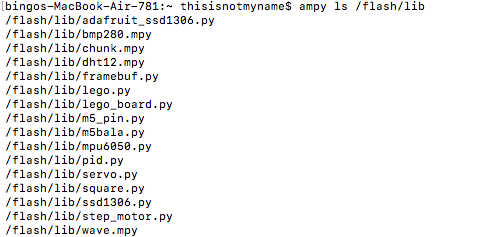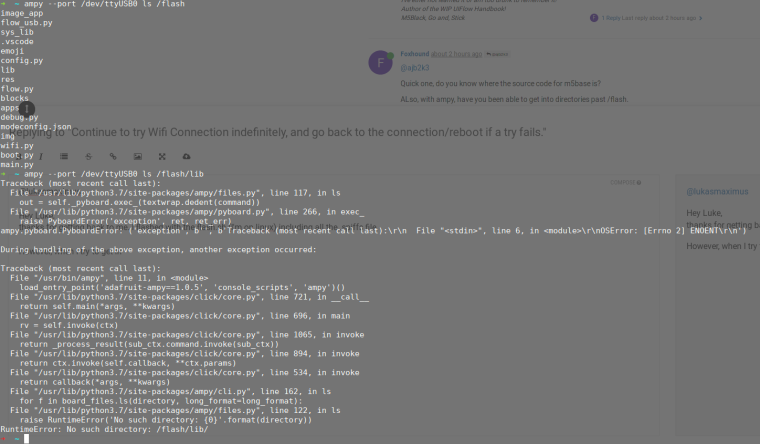Continue to try Wifi Connection indefinitely, and go back to the connection/reboot if a try fails.
-
Interesting, mind throwing me a link to that firmware.
FWIW, what I'm currently using, I setup Wifi and then get to here, where nothing happens (besides io.m5stack.com/#/<id> opening) when I scan it

-
@foxhound on the computer or phone connect to the new M5Stack network and type in the address. This open a page on the M5Stacks internal micro server that allows you to set the M5Stack into station mode connected to your network. Select your network and insert the password and it should connect and restart disconnecting the M5Stack’s internal network. A new page should show up giving The M5Stack’s is code.
In the UIFlow tutorial section is a link to my documents that have a guide to setup, there is an issue with enterprise networks -
Thanks mate, I've followed this; however this is where it lands me after I've connected it to a network (and it's disconnected the M5Stack's internal network). I never get the ID code. DO you have a link to the 1.2.3 firmware you mentioned?
I suspect there is an issue with the firmware I am using. I will look for your guide now. Have you got a link to it?
Thankyou so much for your help, I really appreciate it.
-
@foxhound https://m5stack.oss-cn-shenzhen.aliyuncs.com/resource/software/M5Burner_MacOS.zip
or
https://m5stack.oss-cn-shenzhen.aliyuncs.com/resource/software/M5Burner.zipwhen the downloader fully fils the black circle, wait 20 seconds then press the red button on the m5 stack to reset it then press button C to access setup.
Strange that yours isn't showing the ID code as I've just updated mine and they worked properly. -
-
@foxhound Did you get the connection Successful message when trying to connect?
-
Woohoo!! Thanks so much mate, finally in and have placed my code into the UI Flow Python Editor and have started running it :)
Couple of questions related to my original question regarding wifi.
- How do I permenantly save the code to my device. I can run it, but I when I reboot it doesn't boot into my code again.
- Secondly, how on boot can I edit it so it automatically tries to reconnect if the Wifi isn't found.
Thanks so much for your help, really appreciate it.
-
In the top right hand corner is an icon with 3 horizontal lines, click on that then click on "Download" to permanently save to the M5Go.
I do believe that you use
import wifisetup wifisetup.auto_connect()at the beginning of the file above the
from m5stack import * from m5ui import *Alternatively, save the file as main.py and copy it to the M5Stack using ampy.
-
Awesome, thanks, I'll give this a go.
-
@ajb2k3
Okay awesome, thanks mate, have it working well now. Just need to make some modifications.Auto connect seems to only work when called, and looks like it will throw an error if not connecting. I've found the code on the repo, so I'll modify that to continue trying when booting up if no wifi is found, and upon disconnection, call the function again.
Won't get much time to work on it for a little bit but will report back next week with my progress. Thanks very much for your assistance.
Also, download didn't work but ampy working really well now, thankyou!
-
@foxhound Glad to hear that I could help.
-
Quick one, do you know where the source code for m5base is?
ALso, with ampy, have you been able to get into directories past /flash.
WHenever I try and list things inside say lib(/flash/lib), it say it isn't a directory?
-

-
which micropython version are you using? if you did a custom flash not from the official m5stack burner you may have forgotten to flash the .spiffs file which contains all the folders and files you want to put on the filesystem
-
Hey Luke,
thanks for getting back to me. I flashed with the flash.sh (I'm on linux) including all the .spiffs file.However, when I try to get I get the following.

-
Strange, which version of the firmware are you using, could you post the log from flash.sh process or the command you used, maybe the files are not getting written to the correct memory addresses, usually it should look like this
"--chip esp32 --port %port --baud %baud write_flash -z 0x1000 %PATH\bootloader.bin 0xf000 %PATH\phy_init_data.bin 0x10000 %PATH\MicroPython.bin 0x8000 %PATH\partitions_mpy.bin",
"--chip esp32 --port %port --baud %baud --before default_reset --after no_reset write_flash -z --flash_freq 40m 0x170000 %PATH\spiffs_image_0x170000.img" -
Yep sure will, I'll get it for you tonight.
-
esptool.py --chip esp32 --port /dev/${port} --baud 921600 --before default_reset --after no_reset write_flash -z \ --flash_mode dio --flash_freq 80m --flash_size detect \ 0x1000 bootloader.bin \ 0xf000 phy_init_data.bin \ 0x10000 MicroPython.bin \ 0x8000 partitions_mpy.bin \ 0x170000 spiffs_image_0x170000.imgI have a feeling however, I did not do this properly. However everything seems to be working fine besides not being able to get into the system, and not being able to change font..
-
@foxhound Maybe, you need install python2.7 for compiling this firmware. A year ago, I compiled a micropython firmware with python3. And the serial monitor displayed some error which seem like yours.
-
Good idea, thanks mate!
Also, can you tell me how to properly change the font? I'm trying to increase the size.
lcd.font(FONT_DejaVu18)Doesn't compile
lcd.font("FONT_DejaVu18")Doesn't do anything?